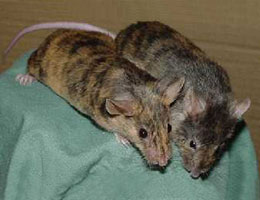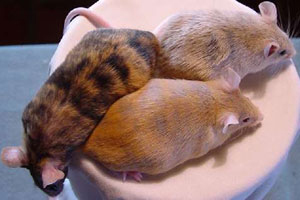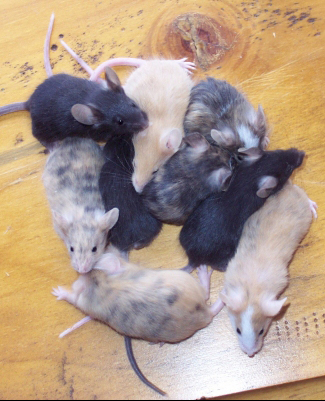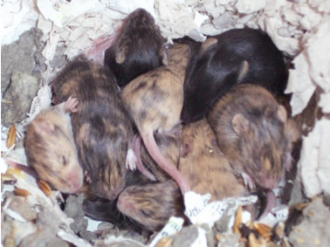Genetics
A-locus
2a. Avy - Viable Yellow
Avy is the second highest dominant on the a-locus. It is a spontaneous mutation and was reported as a new dominant yellow in a study published in 1962 by Margaret M. Dickies.
Like the name implies, Avy/Avy mice are fully viable. However, this gene does not give a problem-free way of breeding red (fawn etc) mice. First of all, Avy resembles Ay in proness to obesity and having tumours. The grade of obesity is dependent on the amount of yellow pigment on the mouse. The yellower (more red) the mouse, the more likely it is also obese. The problems with size and type are the same with Avy as with Av, too.
Furthermore, while Avy can give mice indistinquishable from Ay mice, the effect of Avy is very variable. The phenotype of Avy mice can vary pure yellow (yellow in the genetic sense) mice with darked splashes or stripes to mice that could pass for an agouti. This is called "pseudoagouti". The genotype and other a-locus allele of the mother has a larger effect on the appearance of the young than that of the father.
2a.1. Homozygous forms
In homozygous form, Avy/Avy, the mouse can vary in appearance greatly.
Most Avy/Avy mice resemble Ay/* mice when young, but many of them turn sooty or mottled with each molt (turning sooty isn't anything new for a fancier familiar with Ay). However, this sootiness isn't said to be completely like that seen on Ay/*, nor does it resemble sable. Some homozygotes have a brindling pattern showing already with the first pigment.
Due to being so variable in appearance, homozygous Avy/Avy can be problematic to breed, whether the goal is red, or brindle. Careful selective breeding and paying attention to the genotype of the dam can help in bringing more self yellow mice in a litter - or more mottled ones.
2a.2. Heterozygous forms
Images clickable to larger size. |

ag/bri, Avy/A B/* C/* P/* |

ba/bri Avy/a B/* C/* D/* P/* (left), |
Heterozygous forms of Avy mice can be easier "controlled" in appearance than the homozygous form, and can give quite charming brindles.
Unlike with the sex-linked brindles (only females can be brindles, males resemble astrex siameses and die young) found more easily in Europe, Avy brindles can be of either sex. These mice are also fully viable.
Brindling caused by Avy resembles that caused by Mobr in pattern, but with a differing colouration: dark agouti (or the colour agouti turns to due to the effect of the other a-locus gene and/or dilutes) on genetically yellow background. The other genes present define the base colour (depth of yellow) and the colour of the brindling.
In other words, if the mouse has blue dilution d/d, the yellow pigment isn't red but lighter by about half and the brindling is also diluted into blue agouti (with Avy/A d/d) or blue (with Ay/a d/d).
2a.2.1. Avy/Aw
None of my sources have indicated, that Avy/Aw mice would have a different phenotype than Avy/A mice. See below.
2a.2.2. Avy/A, Agouti Brindle
... and other agouti based brindles.
Avy/A gives the mouse agouti striping on a red background. With bc/* (or b/b), the striping is cinnamon instead of agouti, with the red staying intact. With d/d the stripes turn blue agouti and with both dilutions they are lilac agouti in colour. Blue agouti and lilac agouti brindles have the their red colour diluted to half the intensity.
With p/p, the mouse has almost the same depth of base colour as with P/*, but the striping is argente. With p/p and chocolate dilution, the colouring is almost the same as with argente brindle, only the base of the hairs in the stripes is champagne instead of blue. With blue dilution, the intensity of the red pigment is half of agouti brindle, the "argente" lighter and the base of the hairs are blueish. With both b and d dilutions, the base of the hairs are resemble light lilac.
2a.2.3. Avy/a, Black Brindle
... and other 'self' based brindles.
Avy/a (or Avy/ae) gives the mouse black striping on a red background. With chocolate, blue and pink-eyed dilutions, the colouration follows the same logic as with the agouti based brindles.
2a.2.4. Avy/at
With Avy/at, the belly of the mouse may be tan - unstriped, with stripes ending at the demarcation line. This, however, is mostly speculation, supported only by Mouse Genome Informatics's statement on at's partial dominance (on the belly, not on the back).
2a.2.5. Avy/ae
Following the logic of the above-mentioned agouti and black brindles, one would suppose a Avy/ae mouse would be a black brindle, with both the black and the yellow pigment of deeper intensity.
Images clickable to larger size. |

A litter of Australian Ahvy/* -mice. Note the colour variance! |

Another Ahvy/* litter. |
2b. Ahvy - Hypervariable yellow
The hypervariable yellow produces the greatest amount of colour variation of all "brindling genes". Not surprisingly, it has caused puzzlement within mouse breeders when they have believed they were working with Avy, but litters come out looking like there's one too many a-lokus gene involved. Ahvy produces all possible a-lokus effects from all-yellow through agouti to basically black and mice with agouti brindling on red background all the way to red brindling on black background!
As Avy, Ahvy is likely to be epigenetic. That is, the genotype of the dam has more influence on the fenotype of the young than the sire's.
